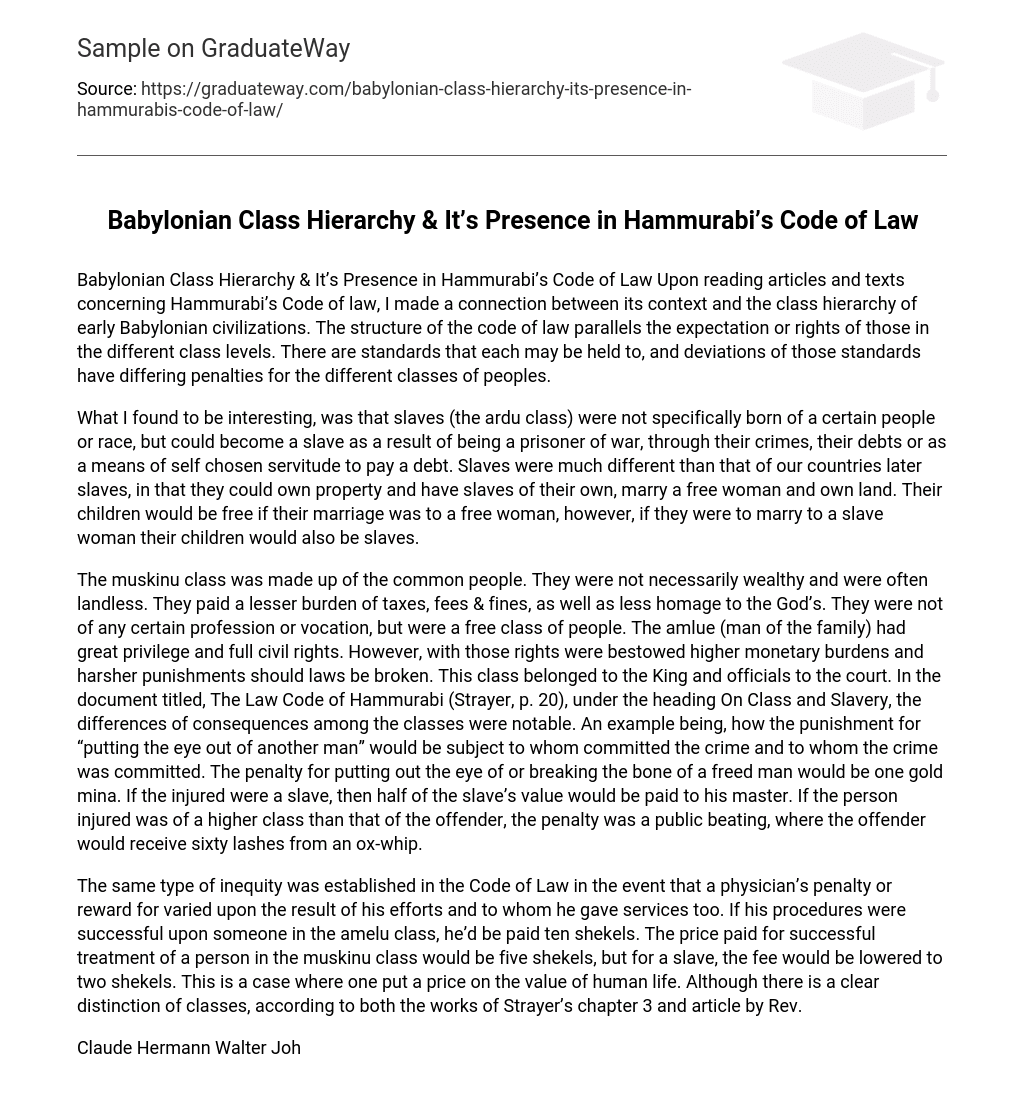Upon reviewing multiple articles and texts regarding Hammurabi’s Code of law, I observed a connection between its historical context and the social structure in ancient Babylonian civilizations. The arrangement of the code reflects the privileges and obligations associated with different levels of society. Each class is subject to specific regulations, and breaches of these regulations lead to varying consequences based on one’s social standing.
What intrigued me was that the ardu class, who were slaves, did not necessarily belong to a specific ethnicity or race. Instead, individuals could become slaves due to being captured during warfare, committing crimes, having debts, or choosing servitude voluntarily to repay a debt. These slaves differed significantly from the later slaves in our countries. They had the ability to own property and have their own slaves, as well as marry free women and own land. If they married a free woman, their children would be born free. However, if they married a slave woman, their children would also be enslaved.
The muskinu class consisted of the common people, who were not wealthy and often had no land. They had a lower tax burden and paid fewer fees and fines. They also showed less respect to the Gods. They did not belong to any specific profession or occupation but were a free class of people. The amlue, who was the head of the family, enjoyed significant privileges and had full civil rights. However, these rights came with greater financial responsibilities and harsher punishments if they violated the laws. This class was under the authority of the King and court officials.
In the document titled The Law Code of Hammurabi (Strayer, p. 20), under the category of On Class and Slavery, there were noticeable differences in the consequences based on social class. For instance, the punishment for “blindfolding another person” would vary depending on who committed the crime and who the crime was committed against. If a freed man’s eye was blinded, the penalty would be one gold mina. However, if a slave’s eye was blinded, his master would receive half of the slave’s value as compensation. In cases where the victim belonged to a higher class than the offender, the penalty involved a public beating, wherein the offender would receive sixty lashes from an ox-whip.
The Code of Law established inequity in terms of penalties and rewards for physicians based on the outcome of their efforts and the class of the individual they treated. Successful procedures on a person in the amelu class resulted in a payment of ten shekels. The fee for successful treatment of a person in the muskinu class was five shekels, while for a slave, it was reduced to two shekels. This demonstrates the valuation of human life. Both Strayer’s chapter 3 and Rev. Claude Hermann Walter Johns, M. A.’s article “Babylonia Law- The Code of Hammurabi” clarify this distinction between classes. I found further clarity in the documents provided in “Considering the Evidence: Life and Afterlife in Mesopotamia & Egypt” (Strayer’s text, pgs. 115-125).
The Be a Scribe document illustrates the unequal conditions faced by different professions and the existence of hierarchies within certain professions, such as Scribes and their varying positions. In addition, The Afterlife of a Pharaoh: A Pyramid Text (Strayer p. 121) discusses how class distinctions will persist even after death in the afterlife.
Mentioned in this text are the hidden ones, the great ones, and the watchers. I interpreted the hidden ones as possibly referring to the commoners, given that it mentioned, “The hidden ones will worship you.” This suggested to me that they would display obedient behavior and show respect for a higher social class. When it said, “The great ones surround you,” it made me think that this pharaoh believed he would become equal to God and be among the great ones who surround Him.
In conclusion, the statement suggests that the watchers will serve you, which I interpreted as slaves in the afterlife, possibly a purgatory for less fortunate spirits. I wonder why the pharaohs required these spells to be inscribed in the pyramids if they were considered equal to gods on Earth. According to Strayer, page 108, the pharaohs were seen as divine beings in human bodies.
It can be inferred that people in ancient Babylon believed in the importance of securing their position in the afterlife. They would pay a fee or make a plea to ensure their place in the afterlife. The class hierarchy in Babylon was believed to exist in both life and the afterlife. The Code of Hammurabi played a significant role in maintaining this hierarchy and providing guidance for society’s order.
Bibliography
- Strayer, Robert W. Ways of the World: A Brief Global History, Volume 1
- Johns, Rev. Claude Herman Walter, The Avolon Project- Babylonian Law: The Code of Hummuri, Yale Law School, Lillian Goldman Law Library, 9/29/2012





